The Sabrent Rocket nano XTRM (SB-XTMN) is an external SSD available in a 1TB capacity model, designed to offer both versatility and portability. Specifically engineered to be compatible with Windows and macOS operating systems, this drive also supports Thunderbolt and USB interfaces and aims to serve as a reliable storage solution for a wide array of users.
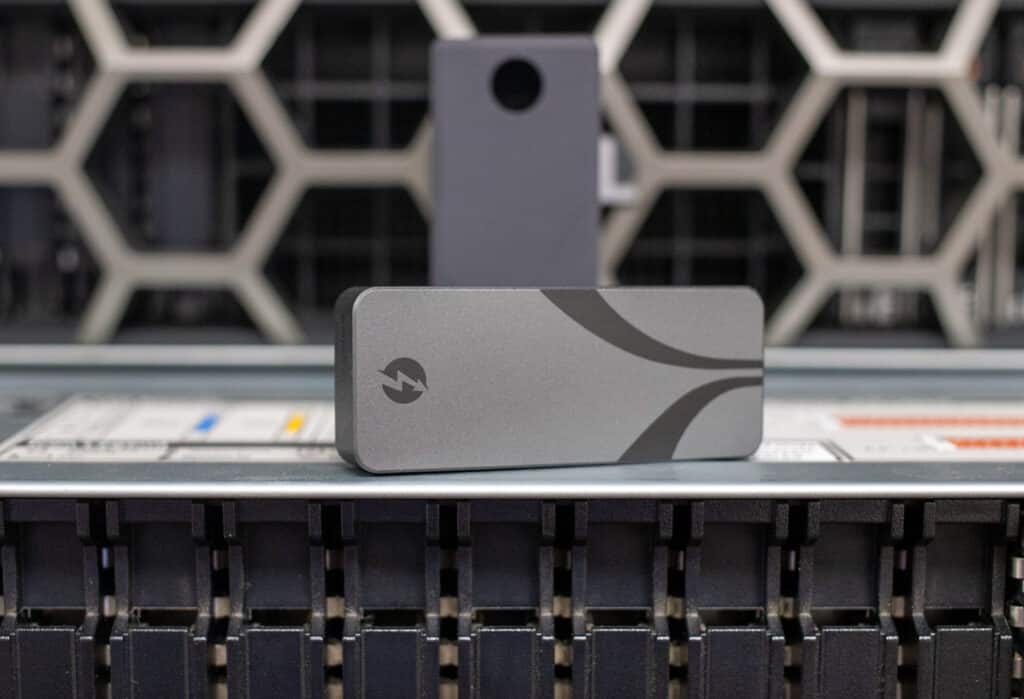
Sabrent Rocket nano XTRM Performance Profile
When it comes to performance, the Rocket nano XTRM offers the usual high-end speed capabilities. Its Thunderbolt 3 interface allows for transfer rates of up to 2700MBps. For those using older interfaces, the SSD also provides USB 3.2 Gen 2×1 compatibility, which supports transfer speeds up to 900MBps. Additionally, it is backward compatible with earlier versions of USB, making it flexible for use with a range of older devices.
Sabrent Rocket nano XTRM Features
Physically, the device aims for superior portability and durability. It is lightweight and compact, constructed with an aluminum body that aids in heat dissipation during operation; however, as you will see in the performance section below, this drive still can get seriously hot.
Convenience is another aspect of the Rocket nano XTRM. It comes with both Thunderbolt and USB-C to USB-A cables, eliminating the need to purchase extra cables for different interfaces. The drive is also bus-powered, requiring no external power source, and offers a plug-and-play experience.
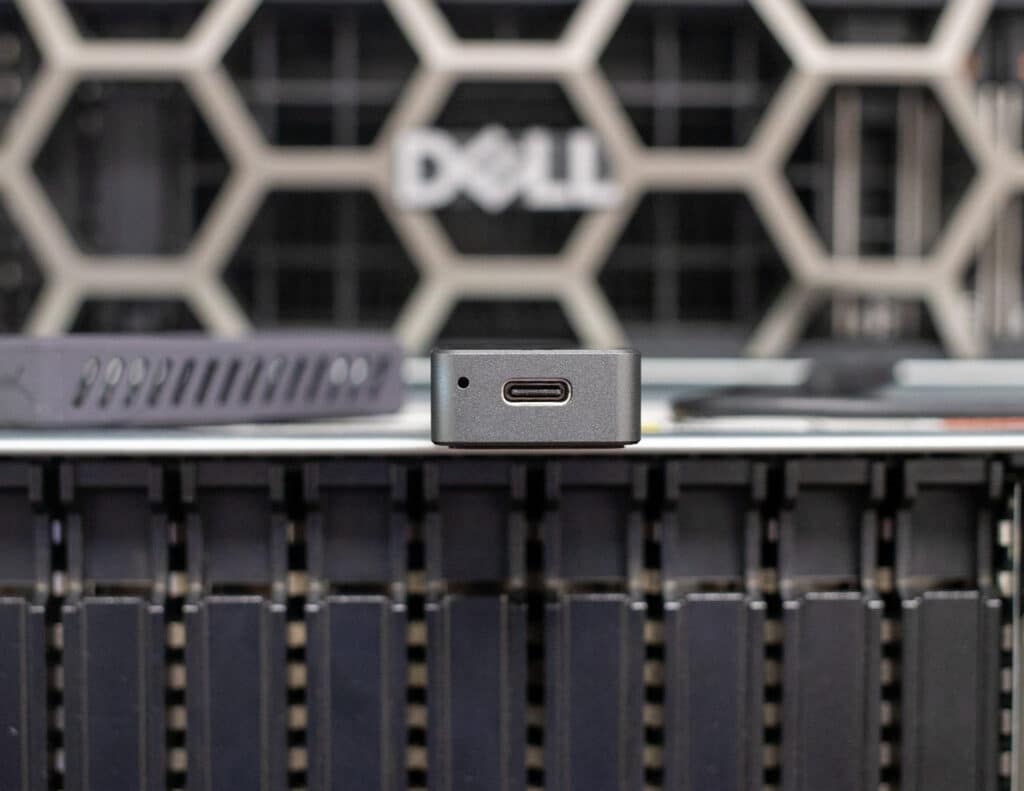
With all that said, the Rocket nano XTRM external SSD seems to be built for a diverse user base that values both speed, portability, and compatibility. Its high-speed data transfer capabilities make it an ideal choice for professionals involved in data-intensive tasks on the go, including most video editing, 3D rendering, or large-file data backup use cases (though it only comes in a 1TB model). On the other hand, its compact and durable design makes it a suitable option for those who are frequently on the move, perhaps for travel or fieldwork.
Moreover, the drive’s compatibility—from Thunderbolt 3 to older USB interfaces—also means it’s well-suited for users who operate in mixed hardware environments (Windows and MacOS), or who may need to switch between newer and older systems.
Backed by a 3-year warranty (which reduces to 1 year if the product is not registered), the 1TB Rocket nano XTRM is available at an approximate price point of $170 at Amazon.
Rocket nano XTRM (SB-XTMN) Specifications
| SKU | SB-XTMN-1TB |
| UPC | 840025259980 |
| Interface | Thunderbolt 3, USB 3.2 Gen 2×1 |
| Speeds | Thunderbolt 3 mode connects at 40Gbps for transfer speeds of up to 2700MBps. USB mode also transfers at up to 900MBps (USB 3.2 Gen 2×1) and has backward compatibility. |
| Material | Aluminum SSD with Silicon Sleeve |
| System Requirement | Designed to work with Windows and macOS systems |
| Dimensions |
|
| What’s in the Box? | Thunderbolt 3 cable, USB C to A cable |
Sabrent Rocket nano XTRM Design and Build
The Rocket nano XTRM (SB-XTMN) is meticulously designed with a focus on both durability and portability, featuring an aluminum body to convey a sleek and premium look and feel. At just 2.2 ounces, the drive is also incredibly lightweight, making it exceptionally convenient to carry. Moreover, at just a mere 2.7 inches in length, 1.1 inches in width, and just 0.5 inches in height, this drive will easily slip into your pocket or any small carry case.
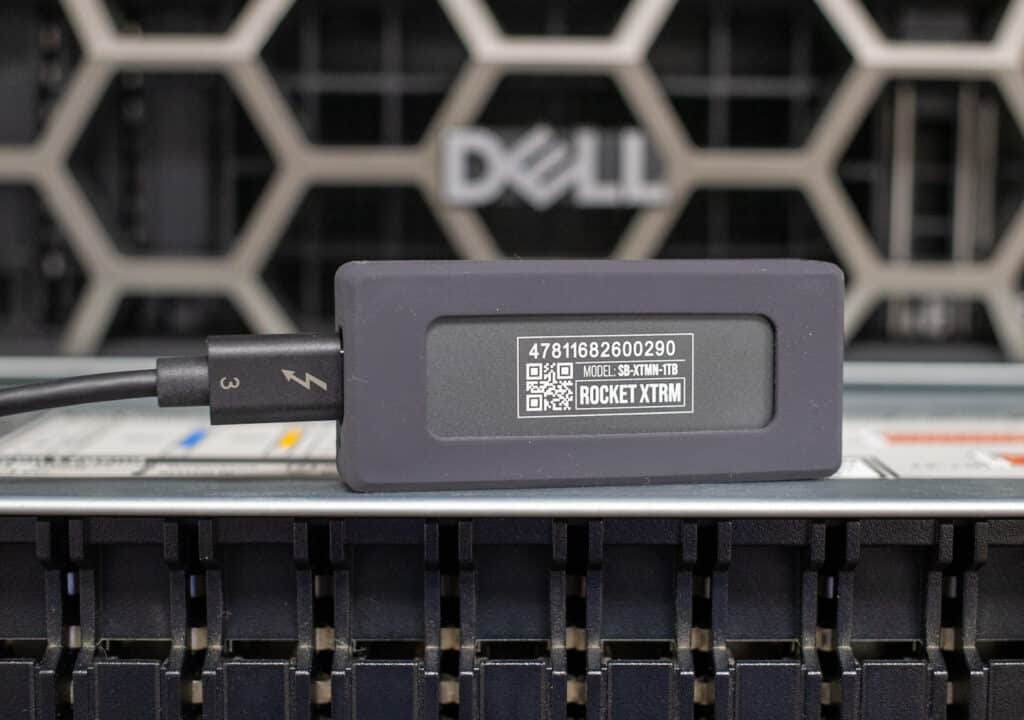
The metal clamshell packaging may seem a bit overkill; however, it certainly allows it to safeguard the drive during shipping, ensuring that it reaches its destination in mint condition. Sabrent includes a Thunderbolt 3 short cable, enhancing the drive’s usability straight out of the box.
The Rocket nano XTRM includes a silicone sleeve that adds protection against accidental drops and physical impacts that may occur during travel or fieldwork. This silicone sleeve also enhances grip and handling—a feature for a portable storage solution designed for life on the go. That said, the rubber sleeve not only protects the drive but is also used to mitigate the effects of heat when handling the drive.
Sabrent Rocket nano XTRM Performance
Blackmagic Disk Speed Test (Mac)
We conducted the BlackMagic disk speed test on the Rocket nano XTRM, spanning approximately 20 minutes. The drive got pretty hot during the test, so we recommend keeping the silicone sheath to protect users. This can be attributed to the drive’s extremely small size, which limits its surface area for effective heat dissipation.
Nonetheless, the Rocket nano XTRM achieved impressive results when connected via Thunderbolt on a MacBook Pro, boasting write speeds of 2,033MB/s and read speeds of 2,731MB/s.
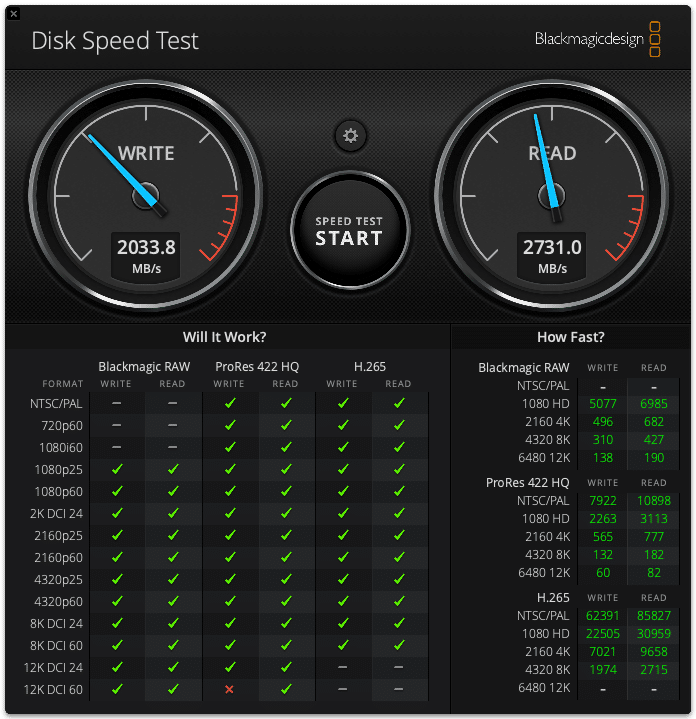
For a point of comparison, we also subjected the SanDisk PRO-G40 2TB—a remarkable portable drive honored with StorageReview’s “Best of 2022” Award—to the same disk speed test, using an identical time frame and utilizing the same USB cable.
The SanDisk drive delivered comparable performance, achieving write speeds of 2,027MB/s and read speeds of 2,687MB/s, effectively matching the speed of the Sabrent SSD. However, it’s worth noting that due to its larger form factor, the SanDisk drive exhibited less pronounced heat buildup.
IOMeter Performance (Windows)
The next test is IOMeter on a Windows rig. Here, we looked at 2MB sequential read/write, 2MB random read/write, and 4K random read/write using both Thunderbolt 4 and USB 3.2 connections. These tests gauge its performance in tasks ranging from large file transfers to everyday computing activities. We will also compare it to the results of the SanDisk PRO-G40, though Thunderbolt 3 only.
In our first test, we used a 1-Thread workload:
| IOMeter (1 Thread) | Sabrent Rocket nano XTRM USB 3.2 Gen2 |
Sabrent Rocket nano XTRM Thunderbolt 3 |
SanDisk PRO-G40 Thunderbolt 3 |
| Seq 2MB Write | 836MB/s | 507MB/s | 1,663MB/s |
| Seq 2MB Read | 870MB/s | 2,306MB/s | 2,399MB/s |
| Random 2MB Write | 837MB/s | 509MB/s | 1,206MB/s |
| Random 2MB Read | 854MB/s | 2,205MB/s | 2,348MB/s |
| Random 4K Write | 16,740MB/s | 939 IOPS | 3,636 IOPS |
| Random 4K Read | 7,201 IOPS | 10,853 IOPS | 11,303 IOPS |
Here you can see the write speeds were much slower than the SanDisk comparable. While this slowdown may be somewhat attributed to its compact size, which tends to generate considerable heat during use and thus performance throttling, it’s likely due to the Windows platform itself.
Compatibility issues with Windows chipsets and related components are common among Thunderbolt SSDs when gauging their USB performance. That said, the SanDisk PRO-G40 seems to be one of the exceptions, showcasing strong performance on both platforms.
When upping the thread count to 4, the Sabrent Rocket nano XTRM demonstrated better results as expected with read performance almost matching the impressive PRO-G40. Improved performance in 4-thread workloads occurs because multiple threads enable the portable SSD to concurrently handle and distribute data requests more efficiently, which maximizes its throughput and responsiveness.
That said, write performance is still very weak when using Thunderbolt 3 connectivity on a Windows machine.
Here is a rundown of the results:
| IOMeter (4 Threads) | Sabrent Rocket nano XTRM USB 3.2 Gen2 |
Sabrent Rocket nano XTRM Thunderbolt 3 |
SanDisk PRO-G40 Thunderbolt 3 |
| Seq 2MB Write | 1,026MB/s | 734MB/s | 2,510MB/s |
| Seq 2MB Read | 1,013MB/s | 2,870MB/s | 2,940MB/s |
| Random 2MB Write | 1,025MB/s | 733MB/s | 1,539MB/s |
| Random 2MB Read | 1,010MB/s | 2,869MB/s | 2,933MB/s |
| Random 4K Write | 68,227 IOPS | 3,729 IOPS | 11,870 IOPS |
| Random 4K Read | 28,706 IOPS | 43,179 IOPS | 43,276 IOPS |
Blackmagic Diskspeed Performance (Windows)
Lastly, is our disk speed test via a Windows system. Using a USB 3.2 connection, the Sabrent Rocket nano XTRM fell just short of 1GB/s, with 956.6MB/s read and 929.8MB/s write.
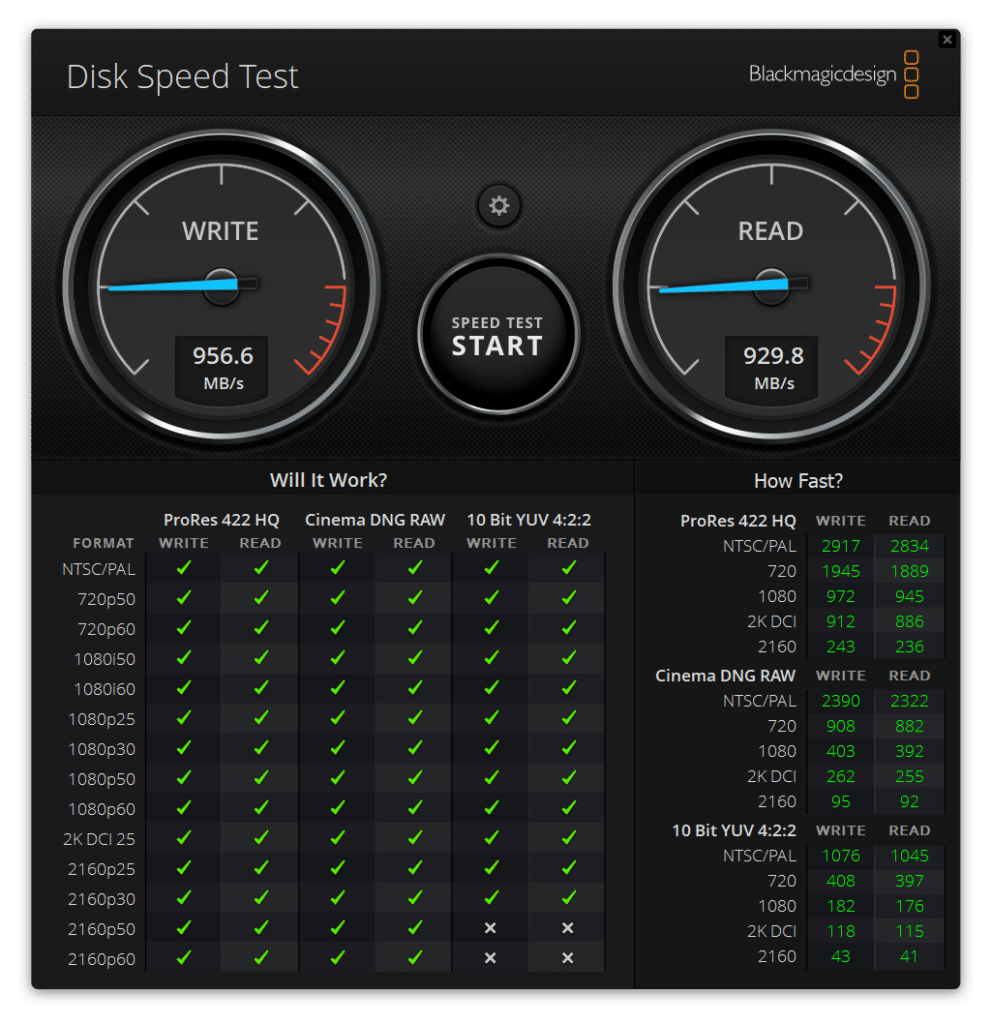
When using a Thunderbolt 3 cable, the Sabrent drive hit an impressive 2,471.4MB/s read. However, writes still seriously struggled, only reaching 544.6MB/s write.
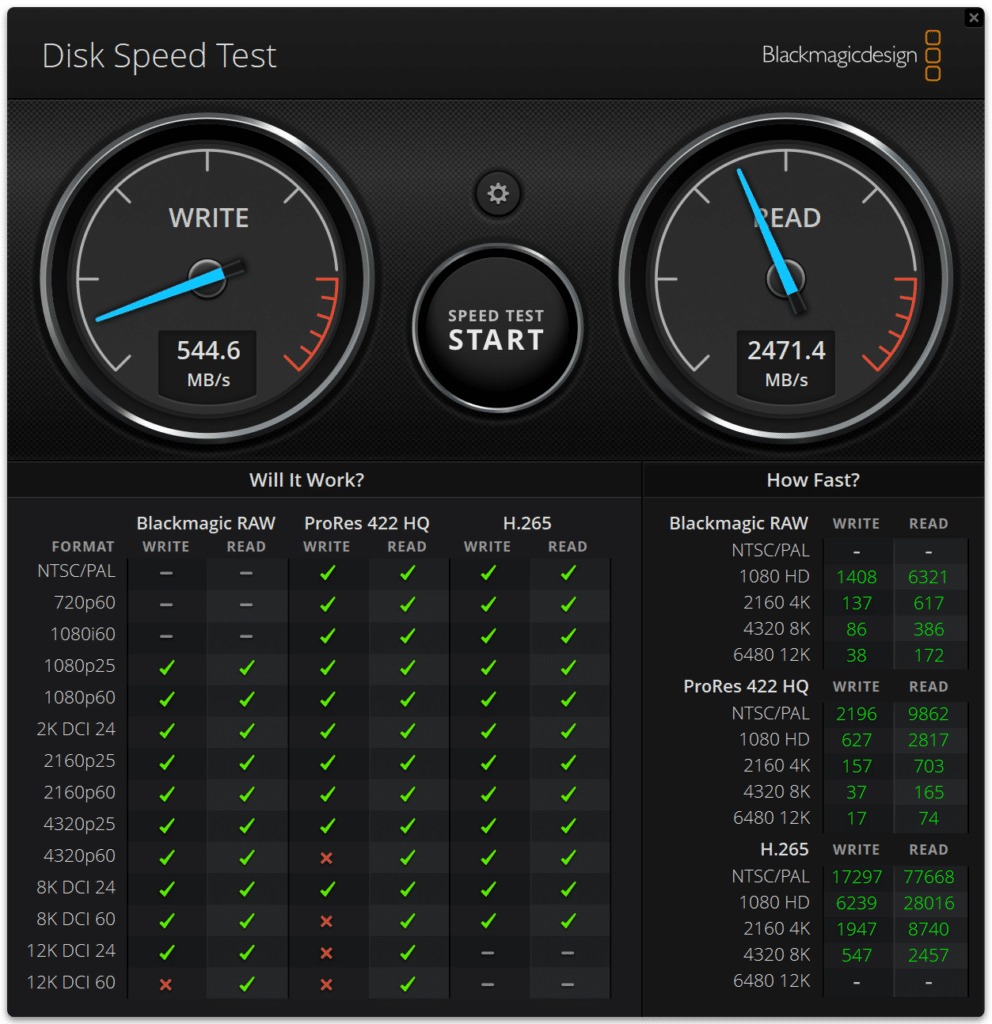
Conclusion
Ultimately, when considering the Sabrent Rocket nano XTRM in the context of the portable SSD market, several key differentiators should be looked at price, warranty, and size. Since performance is usually similar across the board (with no real-world difference during everyday use), these are factors that make it unique among the vast range of options available to consumers.
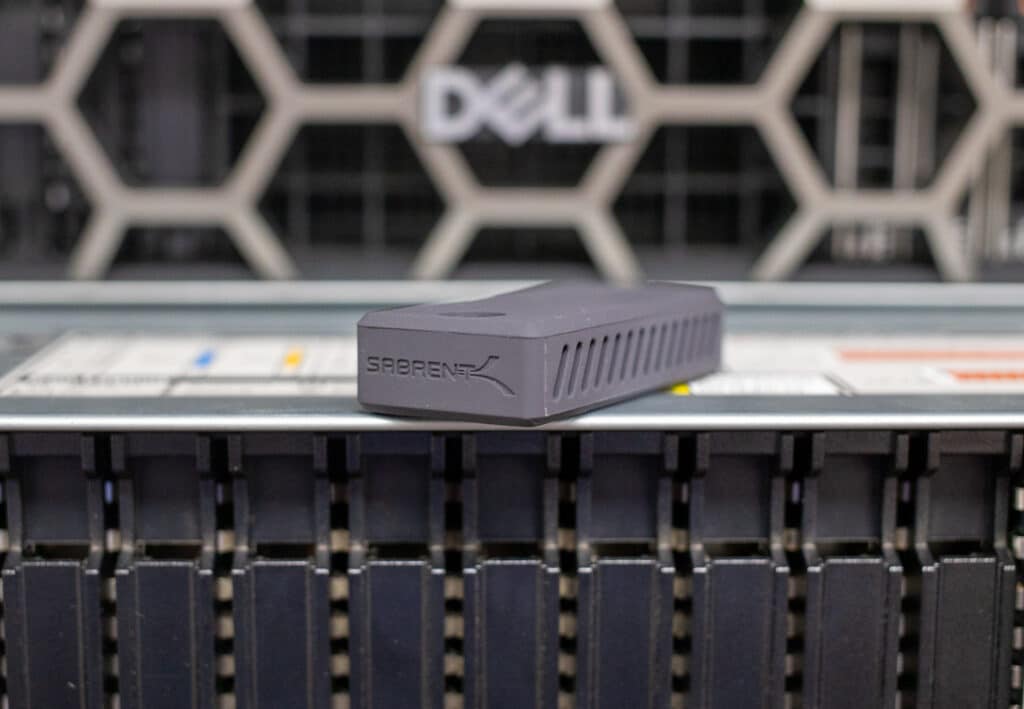
That said, it is still very useful to discuss its performance evaluation, as it does have some caveats. Long use (over 20 minutes) revealed notable heat generation, prompting our recommendation to keep the included silicone sheath for user protection. This thermal behavior can be attributed to the SSD’s remarkably compact size, which limits its surface area for efficient heat dissipation.
Nevertheless, when connected via Thunderbolt to a MacBook Pro, the Rocket nano XTRM delivered impressive performance. However, it’s essential to note a significant disparity in performance when transitioning to a Windows system using Thunderbolt connectivity. Compatibility challenges with Windows chipsets and related components appear to affect most Thunderbolt SSDs, impacting their write performance. Interestingly, the recently reviewed SanDisk PRO-G40 stands out as an exception, showcasing robust performance on both Mac and Windows platforms.
As far as warranty goes, Sabrent offers 3 years of protection (when registered by the user) for the new Rocket nano XTRM at a competitive price point of $170 for the 1TB model, while the SanDisk Professional PRO-G40 (1TB) Thunderbolt 3 portable carries a 5-year warranty at an MSRP of around $160 for the 1TB drive. Looking at the recently reviewed USB 3.2 Gen2x2 portable, the Crucial X10 Pro comes with a 5-year warranty at around $120 for the 1TB model.
Where the Rocket nano XTRM truly distinguishes itself is in its compact size. Measuring a mere 2.7 inches in length, 1.1 inches in width, and just 0.5 inches in height, it’s incredibly pocketable and easy to carry. However, this size does come with a trade-off, as it can get very hot compared to portable SSDs with larger form factors.
Ultimately, the choice between Thunderbolt and USB external SSDs hinges on the trade-off between speed and cost. Thunderbolt drives, including the Rocket nano XTRM, clearly offer superior performance when connected to a compatible port, making them ideal for demanding tasks. However, for those seeking a more budget-friendly option that still delivers excellent performance sufficient for most use cases, USB drives remain an attractive choice. Another point to consider is that, while the nano XTRM offers exceptional portability in a much smaller package, it tends to generate much more heat. Although larger, the SanDisk drive exhibits noticeably less thermal buildup.
In the end, the decision ultimately comes down to individual preferences. The Sabrent Rocket nano XTRM excels in terms of size, affordability, and performance, making it a versatile and highly competitive choice for Thunderbolt users seeking a balance between power and practicality in their portable storage solution.




 Amazon
Amazon